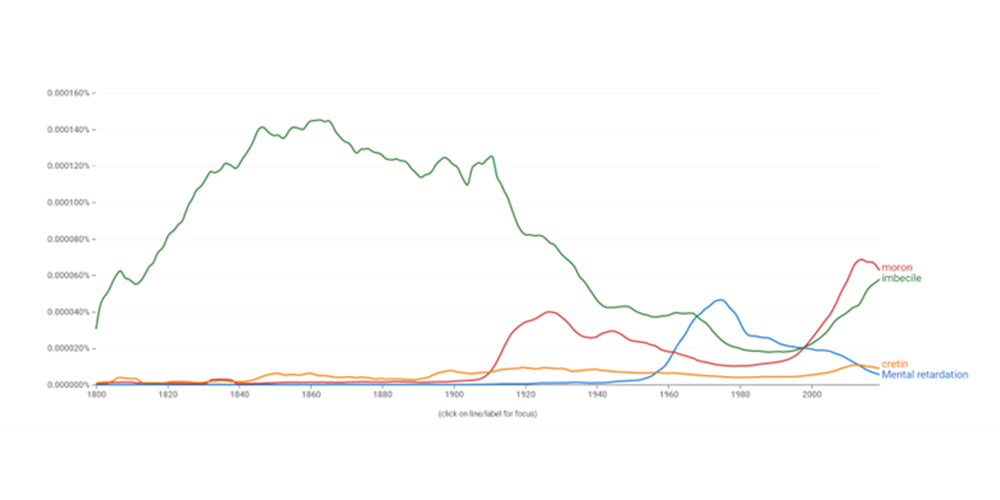Inclusive language: outrunning the euphemism treadmill

Aug 22
The language we use propels itself forward with each new generation that employs it. Whether you’re looking at colloquialisms, professional designations, figures of speech or humour, language reliably evolves with time. We think of this progression as linear and a constant improvement. The more we learn about the world, the better the linguistic tools we use to articulate it and the better our communication becomes.
However, sometimes language can behave strangely – seeming to move forward while stuck in a cycle. This can make inclusive language difficult to perfect because how do you avoid offensive language and slurs when words that were perfectly fine yesterday are cancellable today but their fundamental meaning hasn’t changed?
We’ve just loosely alluded to the euphemism treadmill, a phenomenon where things get a little bit better then worse all over again. Don’t worry; we’re about to explain.
Wait, euphemisms need exercise?
No, there’s no literal treadmill that euphemisms use to stay fit, but there is a figurative one. Psychologist and linguist Stephen Pinker coined the term in a 1994 New York Times article, “The Game of the Name”. He wrote:
“People invent new ‘polite’ words to refer to emotionally laden or distasteful things, but the euphemism becomes tainted by association and the new one that must be found acquires its own negative connotations.
‘Water closet’ becomes ‘toilet’ (originally a term for any body care, as in ‘toilet kit’), which becomes ‘bathroom,’ which becomes ‘rest room,’ which becomes ‘lavatory.’”
How words go bad
Pinker may not have known it when he wrote his op-ed, but his coinage would become a handy tool for social scientists to assess the evolution of slurs related to race, ethnicity, ability and diseases. As political correctness became social consciousness and now wokeness (perhaps another example of the treadmill at work?), finding the right words to address people became non-negotiable – but also tricky – over time.
Let’s look at the case of the R-word.
The term “mental retardation” arose as a clinical term to describe individuals with specific learning and cognitive disabilities in 1895. It replaced older, more offensive terms such as moron and imbecile.
However, as the euphemism treadmill kicked in, mental retardation went from a clinical description and an abstract noun to an adjective (r*tarded), then a concrete noun (r*tard) and finally a suffix (-t*rd) that could be lobbed onto the ends of various insults such as libtard.

This process is called pejoration and can be understood as the motor of the euphemism treadmill. A word will start out with neutral connotations – to retard (verb) something simply means to slow it down or hinder its progress – but, because it is being used to describe something considered taboo or stigmatised such as a learning and cognitive disability, it never shakes off the stigma. So, with enough time, the neutral word takes on a negative and pejorative meaning, requiring a newer and nicer word to take its place. And the cycle repeats.
Let’s look at how far we’ve come from the R-word. The most widely accepted replacement today is “intellectually disabled”. But before we got to it, the euphemism treadmill had churned various other terms such as “mentally handicapped” and “intellectually challenged”. There’s no saying for sure that this is where it will end and, in fact, everything we’ve learned about the euphemism treadmill so far tells us that it isn’t.

This brings us to one of the most important questions…
When does the euphemism treadmill stop rolling?
The realistic expectation is that we might have to keep replacing terms as each new one undergoes pejoration. This is because euphemisms (and, in fact, inclusive language altogether) are only one part of the needed change. Changing our language is a necessary first step but without systematic changes to redress inequality and discrimination, we’ll just keep renaming things into infinity. It’s an ambitious goal but the only way to truly unplug the euphemism treadmill is to end ableism, racism, ageism and all other forms of bigotry that breed slurs. Until then, we all just have to keep updating our vocabularies.
Minding your step
The news isn’t all bleak though. If you’re willing, you can ride the euphemism treadmill, keep up with every change in pace, and potentially learn something new. Here are some quick tips:
- Ask questions. Ask people how they prefer to be addressed without making any assumptions.
- Don’t apply one lesson universally. Some people don’t mind people called disabled while others prefer the term “person with a disability” or PWD. Again, just ask.
- Call out those around you. If you hear someone use a term that fell off the treadmill ages ago, respectfully remind them that times have changed.
- Prepare to be wrong. One day you will use a term that offends someone – don’t be offended by them taking offence.
Inclusive language is just a segment of what makes inclusive marketing work. To get a taste of the bigger picture, download our inclusive marketing guide below and get in touch with us when you’re ready to eliminate ableist, racist, sexist and ageist language from your digital marketing.
Start your inclusive language journey
Download our starter guide.

Related Content